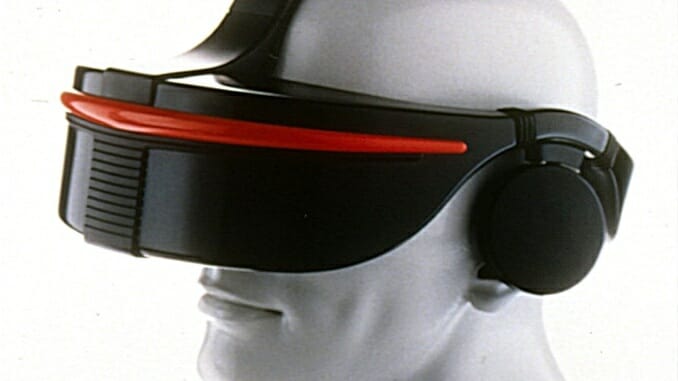Before The Metaverse: Sega’s Forgotten, Never-Released VR Headset
Image via Sega
From films like The Lawnmower Man to Virtuosity — and all the Johnny Mnemonics in between — pop culture really made it feel like we were just one breakthrough away from plugging into virtual reality back in the 1990s. The actual technology available, however, proved otherwise.
But if videogame company Sega had its way all those decades ago, we all might’ve been rocking a sci-fi headset a full 25 years or so before modern-day players like Oculus and PlayStation VR started bringing virtual reality closer to the mainstream. The technology may have still been a long way off, but that didn’t stop companies like Sega from grasping for that ethereal virtual world all those years back.
Riding high on the breakthrough success of the Genesis, Sega was keen to take its love of never-ending accessories and add-ons into the realm of virtual reality. They also wanted to do it at an affordable price point, teasing the VR rig would retail for a mere $200. Was it way too ambitious way too early? No doubt. Did it turn out to be little more than vaporware, only shown off at a handful of trade shows and conventions in private demos? Well, yeah.
But did it also actually kind of work? Indeed, it did.
Back in 1991, Sega was looking to leverage the Genesis’ success and position the hit 16-bit console as the at-home solution to the virtual reality problem we didn’t know we had. SEGA of America spearheaded the project. SEGA’s American and Japanese divisions often pursued parallel projects, with Sega of Japan developing the expensive VR-1 rig that was used as a centerpiece showcase at SegaWorld locations in the late 1990s and early-2000s. But at its core the bare bones of the Sega VR tech weren’t all that different from the ideas that power modern-day virtual headsets, just with a few rudimentary tweaks.
The key piece of tech that made the Sega VR possible came from a relatively small company called One-Sendai, which pitched a much cheaper solution to the head-tracking problem that is critical to making virtual reality actually feel virtual. According to Design News, the One-Sendai tech Sega licensed utilized an azimuthal sensor that responded to the Earth’s magnetic field to determine orientation. A photodetector with a small sphere filled with liquid and gas was monitored with LED and light sensors, tracking the intensity of the LED light as it hit the sphere, which would change as the sphere was tilted.
That tech was cheap to produce and, at a basic level, functioned conceptually well enough to read the movement of a user’s head to adjust the image on the two internal LED screens, creating the illusion of 3D movement. Compared to modern virtual reality tech, which is a mix of cameras and sensors mounted within the headset, the Sega VR solution was low-cost, elegant and almost good enough — at least for the 16-bit era.
-

-

-

-

-

-

-

-

-

-

-

-

-

-

-

-

-

-

-

-

-

-

-

-

-

-

-

-

-

-

-

-

-

-

-

-

-

-

-

-








































